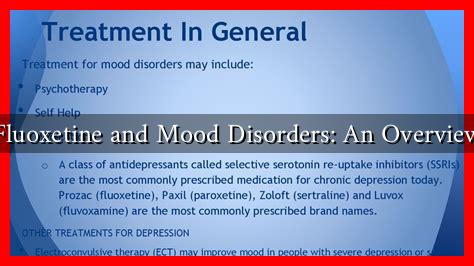-
Table of Contents
Fluoxetine and Mood Disorders: An Overview
Mood disorders, including depression and anxiety, affect millions of people worldwide. Among the various treatment options available, fluoxetine, a selective serotonin reuptake inhibitor (SSRI), has gained prominence for its efficacy in managing these conditions. This article provides an overview of fluoxetine, its mechanism of action, its role in treating mood disorders, and the associated benefits and risks.
Understanding Fluoxetine
Fluoxetine, commonly known by its brand name Prozac, was first approved by the FDA in 1987. It is primarily prescribed for major depressive disorder (MDD), obsessive-compulsive disorder (OCD), bulimia nervosa, and panic disorder. As an SSRI, fluoxetine works by increasing the levels of serotonin in the brain, a neurotransmitter that plays a crucial role in mood regulation.
Mechanism of Action
The effectiveness of fluoxetine in treating mood disorders can be attributed to its mechanism of action:
- Serotonin Reuptake Inhibition: Fluoxetine blocks the reabsorption (reuptake) of serotonin in the brain, making more serotonin available in the synaptic cleft. This increased availability enhances mood and emotional stability.
- Neuroplasticity: Research suggests that fluoxetine may promote neurogenesis (the growth of new neurons) in the hippocampus, an area of the brain associated with mood regulation.
- Long-term Effects: While the immediate effects of fluoxetine can be observed within a few weeks, its long-term benefits may take several months to manifest, as the brain adapts to the increased serotonin levels.
Fluoxetine in Treating Mood Disorders
Fluoxetine is widely used to treat various mood disorders, with significant evidence supporting its efficacy:
Major Depressive Disorder (MDD)
Fluoxetine is one of the first-line treatments for MDD. Clinical studies have shown that:
- Approximately 60-70% of patients experience a significant reduction in depressive symptoms.
- It is particularly effective in patients with atypical features of depression, such as increased appetite and hypersomnia.
Generalized Anxiety Disorder (GAD)
Fluoxetine is also effective in treating GAD, with studies indicating:
- A reduction in anxiety symptoms in about 50-60% of patients.
- Improvement in overall quality of life and functioning.
Obsessive-Compulsive Disorder (OCD)
For OCD, fluoxetine has been shown to:
- Reduce the frequency and intensity of obsessive thoughts and compulsive behaviors.
- Be effective in both adults and children, making it a versatile treatment option.
Benefits and Risks of Fluoxetine
While fluoxetine offers numerous benefits, it is essential to consider potential risks and side effects:
Benefits
- Non-sedating: Unlike some other antidepressants, fluoxetine does not typically cause sedation, making it suitable for daytime use.
- Long half-life: This allows for more flexible dosing and a lower risk of withdrawal symptoms.
- Well-studied: Fluoxetine has a robust body of research supporting its safety and efficacy.
Risks
- Side effects: Common side effects include nausea, insomnia, and sexual dysfunction.
- Withdrawal symptoms: Although less common, some patients may experience withdrawal symptoms if they suddenly stop taking fluoxetine.
- Increased risk of suicidal thoughts: Particularly in young adults and adolescents, fluoxetine may increase the risk of suicidal ideation.
Conclusion
Fluoxetine has proven to be a valuable tool in the treatment of mood disorders, offering significant benefits for many patients. Its ability to enhance serotonin levels in the brain contributes to its effectiveness in managing conditions like MDD, GAD, and OCD. However, it is crucial for patients and healthcare providers to weigh the benefits against potential risks and side effects. Ongoing research continues to explore the full potential of fluoxetine and its role in mental health treatment. For more information on fluoxetine and its applications, you can visit NCBI.

